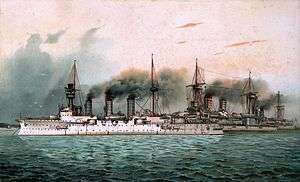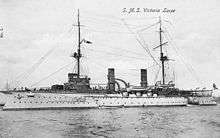SMS Victoria Louise
 Victoria Louise and the battleships Kurfürst Friedrich Wilhelm and Weissenburg | |
| History | |
|---|---|
| Name: | Victoria Louise |
| Namesake: | Princess Viktoria Luise of Prussia |
| Builder: | AG Weser, Bremen |
| Laid down: | 1895 |
| Launched: | 29 March 1897 |
| Commissioned: | 20 February 1899 |
| Struck: | 1 October 1919 |
| Fate: | Scrapped, 1923 |
| General characteristics | |
| Class and type: | Victoria Louise-class protected cruiser |
| Displacement: | Full load: 6,491 t (6,388 long tons) |
| Length: | 110.60 m (362 ft 10 in) |
| Beam: | 17.40 m (57 ft 1 in) |
| Draft: | 6.58 m (21 ft 7 in) |
| Propulsion: |
|
| Speed: | 19.2 knots (36 km/h; 22 mph) |
| Range: | 3,412 nmi (6,319 km; 3,926 mi) at 12 knots (22 km/h; 14 mph) |
| Complement: |
|
| Armament: |
|
SMS Victoria Louise was the lead ship of her class of protected cruisers, built for the German Imperial Navy (Kaiserliche Marine) in the late 1890s. She was laid down at the AG Weser shipyard in 1895, launched in March 1897, and commissioned into the German fleet in February 1899. She was named after Princess Victoria Louise, the daughter of Kaiser Wilhelm II. The ship was armed with a battery of two 21 cm guns and eight 15 cm guns and had a top speed of 19.2 knots (35.6 km/h; 22.1 mph).
Victoria Louise served with the fleet for the first seven years of her career. During this time, she represented Germany during the funeral of Queen Victoria in 1901. In 1906, she was modernized and after 1908, used as a training ship for naval cadets. In 1909, she visited the United States, and at the outbreak of World War I, was mobilized into the 5th Scouting Group. She was attacked unsuccessfully by the British submarine HMS E1 in October 1914, and at the end of the year she was withdrawn from service. She was used as a minelayer and barracks ship based in Danzig for the rest of the war. Victoria Louise was sold in 1919 and converted into a freighter the following year, though she served in this capacity until 1923, when she was broken up for scrap.
Design

Victoria Louise was ordered under the contract name "L" and was laid down at the AG Weser shipyard in Bremen in 1895.[1] She was launched on 29 March 1897, after which fitting-out work commenced. She was commissioned into the German navy on 20 February 1899.[2] The ship was 110.60 meters (362 ft 10 in) long overall and had a beam of 17.40 m (57 ft 1 in) and a draft of 6.58 m (21 ft 7 in) forward. She displaced 6,491 t (6,388 long tons) at full combat load. Her propulsion system consisted of three vertical 4-cylinder triple expansion engines powered by twelve coal-fired Dürr boilers. Her engines provided a top speed of 19.2 knots (35.6 km/h; 22.1 mph) and a range of approximately 3,412 nautical miles (6,319 km; 3,926 mi) at 12 knots (22 km/h; 14 mph). She had a crew of 31 officers and 446 enlisted men.[3]
The ship was armed with two 21 cm SK L/40 guns in single turrets, one forward and one aft. The guns were supplied with 58 rounds of ammunition each. They had a range of 16,300 m (53,500 ft). Victoria Louise also carried eight 15 cm SK L/40 guns. Four were mounted in turrets amidships and the other four were placed in casemates. These guns had a range of 13,700 m (44,900 ft). She also carried ten 8.8 cm SK L/35 guns.[1] The gun armament was rounded out by machine guns.[4] She was also equipped with three 45 cm (18 in) torpedo tubes with eight torpedoes, two launchers were mounted on the broadside and the third was in the bow, all below the waterline.[1]
Service history


Victoria Louise joined the squadron, commanded by Prince Heinrich, that went to Britain to participate in the funeral of Queen Victoria in 1901. Along with Victoria Louise, Baden, Hagen, and Nymphe represented Germany at Spithead.[5] In 1902, Victoria Louise was assigned to the Cruiser Division of the I Squadron of the German home fleet. The Division consisted of the armored cruiser Prinz Heinrich, the flagship, Freya, and the light cruisers Hela, Amazone, and Niobe. The Division participated in the summer fleet maneuvers of August–September 1902.[6] In 1906, the ship went into dock for modernization in the Imperial Dockyard in Kiel.[1] After emerging from the drydock in 1908, Victoria Louise served as a training ship for naval cadets and cabin boys.[2] In September–October 1909, Victoria Louise, Hertha , Dresden, and Bremen traveled to the United States to represent Germany during the Hudson-Fulton Celebration.[7] In 1912, Theodor Krancke served aboard the ship as a cadet; he would go on to command the heavy cruiser Admiral Scheer in World War II.[8]
She served as a school ship until the outbreak of World War I in August 1914.[2] She was briefly mobilized into the 5th Scouting Group, which was tasked with training cadets in the Baltic Sea.[9] Shortly after 0900 on 17 October, the British submarine HMS E1, commanded by Noel Laurence, attempted to torpedo Victoria Louise at a range of 460 m (1,510 ft). The torpedo ran too deep, however, and missed.[10] By the end of 1914, however, the ships were again removed from service.[9] She was put into service as a coastal defense ship. After 1915, she was withdrawn from front-line duty again and employed as a minelayer and barracks ship in Danzig.[2] In 1916, Victoria Louise was disarmed. She remained in service in Danzig until 1 October 1919, when she was stricken from the naval register. She was sold to the Norddeutscher Tiefbau company and rebuilt in 1920 into a freighter. She was renamed Flora Sommerfeld and operated by Danziger Hoch- und Tiefbau GmbH. She served in this capacity only briefly; she was broken up for scrap in 1923 in Danzig.[3]
Notes
References
- Brassey, T.A., ed. (1903). Brassey's Naval Annual. London: J. Griffin & Co.
- Compton-Hall, Richard (2004). Submarines at War 1914–1918. Penzance: Periscope Publishing. ISBN 1904381219.
- Gardiner, Robert, ed. (1979). Conway's All the World's Fighting Ships 1860–1905. Greenwich: Conway Maritime Press. ISBN 0-8317-0302-4.
- Gardiner, Robert; Gray, Randal, eds. (1984). Conway's All the World's Fighting Ships: 1906–1922. Annapolis: Naval Institute Press. ISBN 0870219073.
- Gröner, Erich (1990). German Warships 1815–1945. Annapolis, MD: Naval Institute Press. ISBN 0870217909.
- Levine, Edward F.; Panetta, Roger (2009). Hudson–Fulton Celebration Of 1909. Charleston, SC: Arcadia Pub. ISBN 9780738562810.
- Mitcham, Samuel W. (2009). Defenders Of Fortress Europe. Washington, DC: Potomac Books. ISBN 9781597972741.
- "Naval Notes". R.U.S.I. Journal. London: Royal United Services Institute for Defence Studies. XLV: 190–207. 1901.